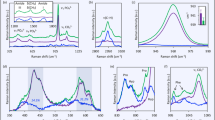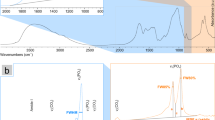Summary
The environment of carbonate ions in bones of different species (rat, rabbit, chicken, cow, human) was investigated by Fourier Transform Infrared Spectroscopy (FTIR) associated with a self-deconvolution technique. The carbonate bands in thev 2 CO 2−3 domain show three components which were identified by using synthetic standards and different properties of the apatitic structure (ionic affinity for crystallographic locations, ionic exchange). The major component at 871 cm−1 is due to carbonate ions located in PO 3−4 sites (type B carbonate). A band at 878 cm−1 was exclusively assigned to carbonate ions substituting for OH− ions in the apatitic structure (type A carbonate). A band at 866 cm−1 not previously observed was shown to correspond to a labile carbonate environment. The intensity ratio of type A to type B carbonate appears remarkably constant in all bone samples. The 866 cm−1 carbonate band varies in its relative intensity in different species.
Similar content being viewed by others
References
Arends J, Jongebloed WL (1981) Apatite single crystals. Formation, dissolution and influence, of CO3 2− ions. Recveil Rev 100(1):3–9
Biltz RM, Pellegrino ED (1977) The nature of bone carbonate. Clin Orthop Rel Res 129:279–292
Hallsworth AS, Weatherell JA, Robinson C (1973) Loss of carbonate during the first stages of enamel caries. Caries Res 7:345–348
Biltz RM, Pellegrino ED (1981) Skeletal carbonates and acid-base regulation. Mineral Electrolyte Metal 5:1–7
Elliott JC (1964) The crystallographic structure of dental enamel and related apatites. Ph.D. Thesis, Univeristy of London.
Elliott JC, Holcomb DW, Young RA (1985) Infrared determination of the degree of substitution of hydroxyl by carbonate ions in human dental enamel. Calcif Tissue Int 37:372–375
Termine JD, Eanes ED, Greenfield DJ, Nylen MU (1973) Hydrazine deproteinated bone mineral. Calcif Tissue Res 12:73–90
Emerson WH, Fischer ED (1962) The infrared absorption spectra of carbonate in calcified tissues. Arch Oral Biol 7:671–683
Baxter JD, Biltz RM, Pellegrino ED (1966) The physical state of bone carbonate: a comparative infrared study in several, mineralized tissues. Yale J Biol Med 3:456–470
LeGeros RZ, Trautz OR, Klein E, LeGeros JP (1969) Two types of carbonates substitution in the apatite structure. Experientia 25(1):5–7
Nelson DGA, Featherstone, JDB (1982) Preparation analysis and characterization of carbonated apatites. Calcif Tissue Int 34:S69–81
Suzuki M (1974) A study of physicochemical nature of hard tissues. Hirosaki Igaku 26:20–25
LeGros R, Balmain N, Bonel G (1986) Structure and composition of the mineral phase of periosteal bone. J Chem Res Synop 1:8–9
Kaupinen JK, Moffatt DJ, Mantsch HH, Cameron DG (1981) Fourier self-deconvolution: a method for resolving intrinsically overlapped bands. Appl Spect 35: 271–276
Roufosse AH, Landis WJ, Sabine NK, Glimcher MJ (1979) Identification of brushite in newly deposited bone mineral from embryonic chicks. J Ultrastruct Res 68:235–255
Trombe JC, Bonel G, Montel G (1969) Etude par spectrometrie d'absorption dans l'infrarouge de l'ion carbonate dans quelques apatites preparées a haute température. CR Acad Sci Paris 268:941–944
Vignoles-Montrejaud M (1984) Contribution a l'étude des apatites carbonatées de type B These d'Etat, I.N.P. Toulouse
Roufosse AH, Aue JE, Roberts JE, Glimcher MJ, Griffin RG (1984) Investigation of the mineral phases of bone by solid-state phorphorus 31 major angle sample spinning nuclear magnetic resonance. Biochemistry 23:6115–6126
Pellegrino ED, Biltz RM (1972) Mineralization in the chicks embryo: I monohydrogen phosphate and carbonate relationships during maturation of bone crystals complex. Calcif Tissue Res 10:128–135
LeGeros RZ, Kijkowska R, LeGeros JP, Abergas T, Bleiwas H (1987) CO3-for-OH (type A) and CO3-for-PO4 (type B) substitutions in precipiated carbonate-apatites. IADR Meeting Abstracts, J Dent Res 66–190
Gee A, Dietz VR (1955) Pyrophosphate formation upon ignition of precipitated basic calcium phosphate. J Am Chem Soc 77:2961–2965
LeGeros RZ, LeGeros JP (1983) Carbonate analysis of synthetic mineral and biological apatites. IADR Meeting Abstracts. J Dent Res 62–259
Bonel G (1972) Contribution a l'étude de la carbonatation des apatites. Ann Chim 7:127–144
LeGeros RZ, Trautz OR, LeGeros JP, Klein E (1968) Carbonate substitution in the apatitic structure. Bull Soc Chim Fr 1712–1718
Trombe JC (1972) Contribution a l'Etude de la decomposition et de la reactivite de certaines apatites hydroxylées carbonatées ou Fluorées alcalino terreuses. Thèse d'Etat, Université P. Sabitier Toulouse
Roux P (1982) Contribution a l'Etude du comportement et de la synthèse des apatites carbonatées sous haute pression. Thèse d'Etat, I.N.P. Toulouse
McClellan GH, Guerry H, Lehr JR (1969) Crystal chemical investigations of natural apatites. An. Miner. 54:1374–1391
Blumenthal NC, Posner AS (1973) Hydroxyapatite: mechanisms of formation and properties. Calcif Tissue Res 13:235–243
Vignoles C (1973) Contribution a l'étude de l'influence des ions alcalins sur la carbonatation dans les sites de type B des apatites phosphocalciques. These de 3 cycle I.N.P. Toulouse
Biltz RM, Pellegrino ED (1971) The hydroxyl content of calcified tissue mineral. Calcif Tissue Res 7:259
Grynpas MD, Bonar LC, Glimcher MJ (1984) Failure to detect an amorphous calcium-phosphate solid phase in bone mineral: a radial distribution function study. Calcif Tissue Int 36:291–301
Posner AS, Botts F (1975) Synthetic amorphous calcium phosphate and its relation to bone mineral structure. Acc Chem Res 8:273–281
Triffitt JT, Terepka AR, Neuman WF (1968) A comparative study of the exchange, in vivo of major constituents of bone mineral. Calcif Tissue Res 2:165–176
Hendricks SB, Hill WL (1950) The nature of bone and phosphate rocks. Proc Natl Acad Sci 36:731
Johnson NW (1966) Difference in the shape of human enamel crystallites after partial destruction by caries, EDTA, and various acids. Arch Oral Biol 11:1421–1424
Daculsi G, LeGeros RZ (1986) Central dark lines in synthetic and biological apatites. IADR Meeting Abstracts. J Dent Res 65:802
Author information
Authors and Affiliations
Rights and permissions
About this article
Cite this article
Rey, C., Collins, B., Goehl, T. et al. The carbonate environment in bone mineral: A resolution-enhanced fourier transform infrared spectroscopy study. Calcif Tissue Int 45, 157–164 (1989). https://doi.org/10.1007/BF02556059
Received:
Accepted:
Issue Date:
DOI: https://doi.org/10.1007/BF02556059




